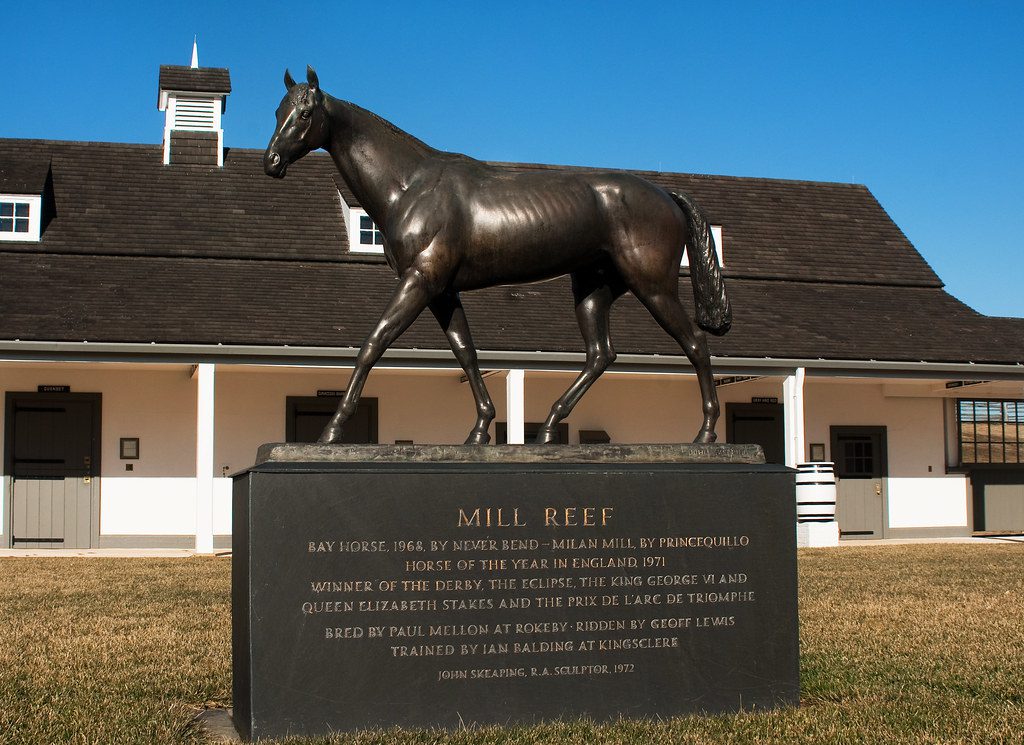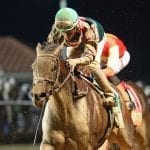BackTracks: The mighty Mill Reef
Never Bend was not supposed to get a stayer. As a racehorse, he had fallen short at distances beyond nine furlongs, finishing second in the Kentucky Derby and the Woodward Stakes and then third in the Preakness Stakes. As he entered the breeding shed, the expectation was that he would not sire horses that could stay, with Iron Ruler, who hit his limit at a mile, and Triple Bend, who set a world record for seven furlongs, seeming to bear that out.
Yet his son Mill Reef proved that assumption wrong. In his three seasons on the English turf, Paul Mellon’s Mill Reef was a sensation, winning consistently from his debut onward, and stood as one of the best horses to emerge in the second half of the 20th century. From his Virginia roots to his thrilling wins at both Epsom and Longchamp, Mill Reef connects the Mid-Atlantic with the historic racetracks of both England and France.
By the early 1970s, Paul Mellon’s Rokeby Stables in Upperville, Virginia had produced classic winners like Arts and Letters and Quadrangle, and turf champions like Run the Gantlet and Fort Marcy. To complement his American stable of flat and steeplechase horses, he also had an English division, trained by Ian Balding. Their early collaborations included a win in the Coventry Stakes at Royal Ascot with Silly Season, who would go on to victories in the St. James’s Palace and Champion Stakes at three.
Among the Rokeby broodmare band was a young mare named Milan Mill. She had raced only once and then was sent back to the growing Virginia stud to pass her pedigree, which included Princequillo and Count Fleet, along to the next generation. In late February 1968, she produced her second foal by Never Bend, a bright bay colt with a wee smudge of white on his forehead. Mellon would name him Mill Reef in honor of a stretch of coastline near his winter home in Antigua.
Early on, Mill Reef’s build and action favored sending him to England and its undulating grass courses rather than keeping him in America to run on dirt. His initial tests showed Balding that this son of Never Bend was going to be a special one. The trainer asked exercise rider John Hallum to send Mill Reef a stride head of the lead horse, but that stride soon turned into 20 lengths.
Afterwards, Balding chided Hallum, “John, I told you to just go a stride faster,” to which the rider replied, “Guvnor, I promise you, that’s all I was doing.” Mill Reef’s turn of foot that day showed Balding a hint of what was to come.
CHECK OUT THE LATEST OFF TO THE RACES RADIO!
Extraordinary Talent
His first start was the Salisbury Stakes at Salisbury, where he surprised everyone, including Lester Piggott on the favorite Fireside Chat, with his fast start and sweeping finish.
“One moment, he’ll be standing there half-asleep,” jockey Geoff Lewis said of Mill Reef’s approach to the starting gate, “the next, you’d better hang on tight.”
Mill Reef followed that sensational debut with wins in the Coventry Stakes at Royal Ascot, and then the Dewhurst, Gimcrack, and Imperial Stakes to round out an astonishing juvenile season.

Lewis told Balding, “This is the best you ever had – or ever will have.”
At 15.2 hands, the Never Bend colt was a specimen already, with a balanced frame and supple conformation that blended a powerful stride with natural grace of motion. The quality evident in his physical being and his juvenile season made his defeat in the Two Thousand Guineas the following season all the more surprising.
In the short field of six were the top three sophomores of 1971, My Swallow, Brigadier General, and Mill Reef. The three hooked up in the last half of the one-mile English classic, but Brigadier General was the best of them all that day. The defeat left Balding unsure about Mill Reef’s ability beyond a mile, but the way that the colt was running toward the end of the Guineas gave his jockey confidence that Mill Reef would have no trouble with the 1½-mile Derby at Epsom. Sure enough, Lewis was right.
Flanked by John Hallum and farrier Tom Reilly to keep him calm, Mill Reef was the class of the 1971 Derby field. He went into the race with newly shod front hooves after partially pulling those plates off playing with the concrete frame of his Epsom stall. By the time he reached the starting gate for the English classic, Mill Reef was calm, cool, and ready for his turn around the course. He had no trouble with the field of twenty others, dropping behind the front runners early and then confronting Linden Tree in the stretch. Lewis tapped Mill Reef and rode him hard through the final furlongs to keep Linden Tree at bay as they approached the wire. In the end it was Mill Reef by two.
After the Derby, the Rokeby colt took the Eclipse Stakes and then the King George VI and Queen Elizabeth Stakes before traveling to France for the Prix de l’Arc de Triomphe in October 1971. He still had plenty in the tank after his long season of racing to beat a field of seventeen others in the French classic, setting a course record in the process. That was the final appearance of his three-year-old season, and all signs pointed toward more of the same in 1972.
[WATCH: Mill Reef wins the Arc]
Bittersweet Ends
His four-year-old season started with a win in the Prix Ganay back at Longchamp and then Mill Reef made a late spring appearance at Epsom in the Coronation Cup. While his Ganay win had been an easy one, the Rokeby star had to work uncharacteristically hard to win the Coronation Cup by a neck over Homeric. Afterward, Balding had the colt go through a battery of tests, including bloodwork, with the results indicating that nothing was amiss with the champion. Instead, an abscess in the colt’s mouth likely explained the off performance.
A subsequent rash of respiratory infections in the stable kept Mill Reef and many of Balding’s horses out of competition, but the goal remained another trip to the Prix de l’Arc de Triomphe. In anticipation of the Cumberland Lodge, the race the trainer selected as Mill Reef’s prep for the French classic, he sent the colt out for a gallop with John Hallum again in the saddle. When the rider heard that crack, the world came crashing down.
Mill Reef had shattered the cannon bone in his left foreleg, taking the sesamoids with it. The injury certainly meant the end of his career, and, possibly, the star colt’s life. Yet Mill Reef’s amiable nature and sturdy determination got him through the surgery and the recovery that followed. With a steel plate and pins inserted into the bones, Mill Reef survived to build a stud career that rivaled how accomplished he was on the racetrack.
Famed Finale
Paul Mellon generally kept his English stallions at the National Stud near Newmarket, but, when Mill Reef’s injury ended his racing career, the breeder and owner was torn. He had received a substantial offer to stand Mill Reef in the United States, which would have made him accessible to his breeding operation at Rokeby in Virginia. Mellon remained committed to contributing to English racing through the breeding side of the sport and stood Mill Reef at the National Stud. There, he sired 394 foals with 239 winners and 63 stakes winners, including Derby winners Shirley Heights and Reference Point.
In a career cut short by injury, the Virginia-bred Mill Reef did enough to merit John Oaksey’s biography of the Never Bend colt, published in 1974, just a year after that fateful day. He recounts the stories that brought the colt the kind of fame that saw fans wearing scarves in the Rokeby black and gold to cheer him on at Longchamps.
“In just three years of cheerful service,” Oaksey wrote, “Mill Reef had given more pleasure and excitement than most men generate in a lifetime,” a fitting tribute to this Mid-Atlantic bred champion.
SOURCES
- https://horseracinghof.com/hall-of-famers/mill-reef/
- https://trainermagazine.com/european-trainer-articles/tag/Mill+Reef
- https://www.michaelchurchracingbooks.com/mill-reef-50-years-on-his-career-and-legacy/
- https://eclipsemagazine.co.uk/ian-balding-mill-reef-and-the-derby/
- https://www.racingtv.com/news/horses-that-made-history-mill-reef-journey-was-mix-of-delight-and-despair
- https://www.horseandhound.co.uk/features/mill-reef-derby-winner-747283
- https://www.thoroughbreddailynews.com/remembering-reef-shared-archive/
- https://www.pedigreequery.com/milan+mill
- https://www.racingmuseum.org/hall-of-fame/pillar/paul-r-mellon
- https://www.bloodhorse.com/horse-racing/articles/241013/deconstructing-black-caviar
- https://www.kingsclere.com/
- https://www.americasbestracing.net/the-sport/2019-paul-mellon-pillar-the-turf
- http://www.americanclassicpedigrees.com/mill-reef.html
- http://www.americanclassicpedigrees.com/never-bend.html
- https://en.wikipedia.org/wiki/Mill_Reef
- https://en.wikipedia.org/wiki/Rokeby_Stables
- https://en.wikipedia.org/wiki/Paul_Mellon
- https://en.wikipedia.org/wiki/Never_Bend
- https://en.wikipedia.org/wiki/St_James%27s_Palace_Stakes
- https://en.wikipedia.org/wiki/Champion_Stakes
- https://en.wikipedia.org/wiki/Coronation_Cup
- https://en.wikipedia.org/wiki/Brigadier_Gerard_(horse)
- https://en.wikipedia.org/wiki/My_Swallow
Oaksey, John. The Story of Mill Reef. London: W.H. Allen & Company, 1974.
LATEST NEWS














